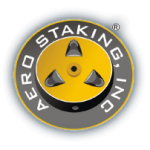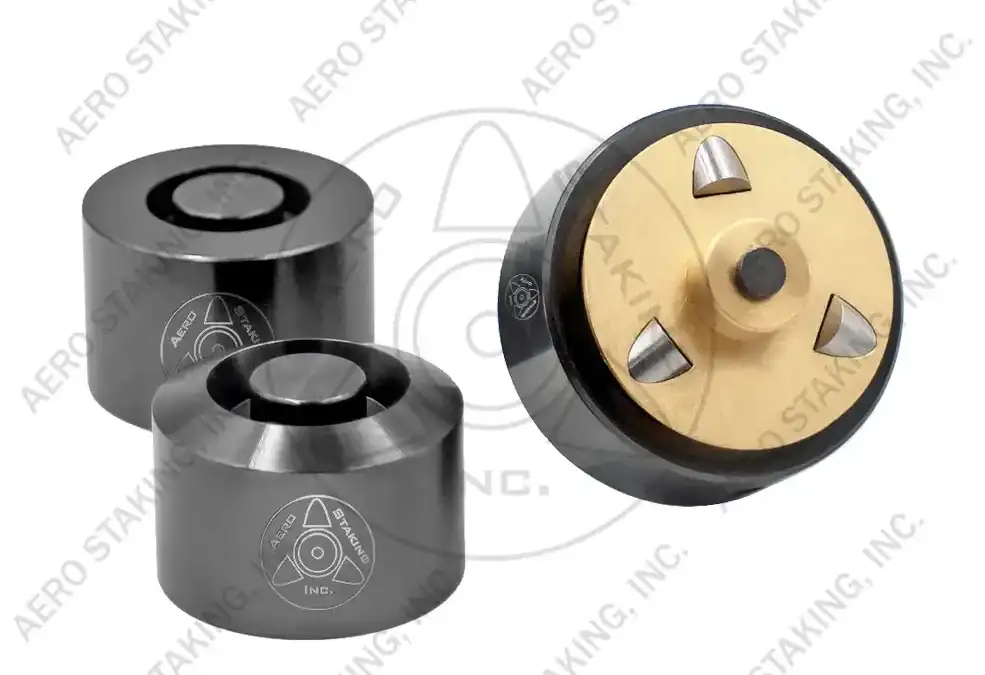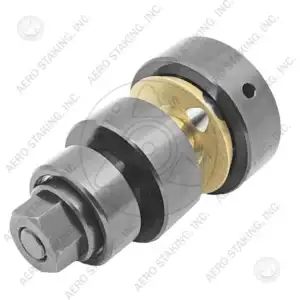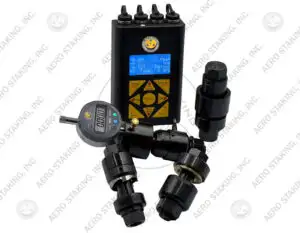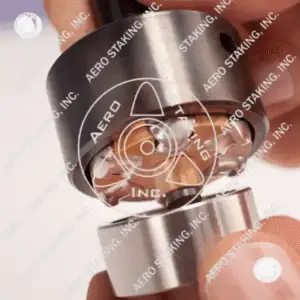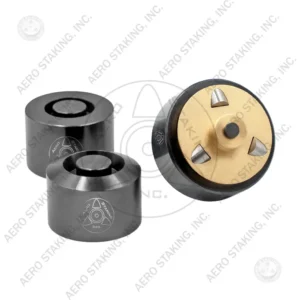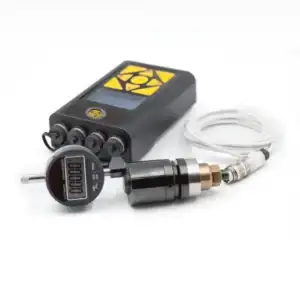When precision matters most, bearing swaging tools are the go-to choice in aerospace, defense, and high-stakes industrial environments. They might not be flashy, but they play a critical role in securing the integrity of everything from fighter jets to spacecraft. So, what is bearing swaging exactly? How does it differ from bearing staking? And why are bearing swaging tools considered essential for OEM and MIL‑B‑81935 compliance?
In this guide, we unpack everything you need to know about the swaging process aerospace teams rely on, including the swaging tool for bearings that make it all possible. We also spotlight Aero Staking, a leading manufacturer of bearing‑swaging tools engineered to meet the world’s toughest OEM and MIL‑SPEC standards.
What Is Bearing Swaging and Why It Matters
Bearing swaging is a cold-forming process used to secure a bearing in its housing by permanently deforming the surrounding material. It creates a full-circle, or 360°, mechanical lock around the outer race of a bearing.
- Cold forming bearing retention avoids the use of adhesives or heat.
- Maintains concentricity between housing and bearing.
- Perfect for aerospace bearing installation, where even the slightest misalignment can lead to vibration or failure.
- Fully compliant with MIL‑B‑81935 and MS bearing installation tools requirements.
It’s a long-term solution for precision-focused applications.
Why Bearing Swaging Is Used in Aerospace
Bearing swaging is particularly important in aerospace manufacturing and maintenance because it:
- Ensures precise retention under vibration, shock, and high‑load conditions.
- Eliminates adhesives or welding, which may be unacceptable in aerospace structures.
- Maintains concentricity, reducing the risk of bearing rotation or migration over the life of the component.
Swaging conforms to multiple standards, including MIL‑B‑81935 (bearing retention) and numerous MS (Military Standard) drawings, as well as individual OEM specifications from manufacturers like Boeing, Airbus, and Lockheed Martin.
Simply put, if it flies or it fights, it likely uses bearing swaging tools.
OEM vs MIL‑SPEC—What’s the Difference?
Before you grab your swaging tool for bearings, you need to know what standards you’re up against. Let’s break it down.
What Does OEM Mean?
Original Equipment Manufacturer (OEM) specs are set by the companies that design and build aircraft or systems. If a part or tool is OEM-approved:
- It’s a perfect match for specific aircraft platforms.
- Meets exact tolerances and quality requirements.
- Maintains type certification and product warranty.
What Is MIL‑SPEC?
The U.S. Department of Defense sets MIL‑SPEC and MS standards. These define:
- Minimum quality, performance, and testing thresholds.
- Universal guidelines for use across all military platforms.
| Term | Stands For | Who Sets the Standard? | What It Means in Practice |
| OEM | Original Equipment Manufacturer | The company that originally designed and built the aircraft, engine, or subsystem (e.g., Boeing, Airbus, Pratt & Whitney) | Parts, tools, or processes labeled “OEM‑approved” conform exactly to that manufacturer’s drawings, materials, tolerances, and quality requirements. Meeting OEM specs ensures the component is a drop‑in replacement that preserves the product’s type certification and warranty. |
| MIL‑SPEC / MS | Military Specification / Military Standard | The U.S. Department of Defense (DoD) | A MIL‑SPEC (or MS drawing) defines the minimum performance, material, and testing criteria a product or process must meet for use in DoD contracts. Tools or components that meet MIL‑SPEC can be used on any military platform, regardless of the OEM, because they satisfy uniform DoD requirements. |
Why Both Matter for Bearing Swaging
In short, OEM compliance keeps aircraft as the designer intended. MIL‑B‑81935 compliance ensures that any bearing swaging tools used will be trusted across any defense contract.
Tools Used for Bearing Swaging
Proper tools are the heart of effective cold forming bearing retention. These aren’t your average workshop items.
Aero Staking’s AST Tool Lineup
The AST1000 through AST1010 series by Aero Staking are:
- Designed specifically for aerospace bearing installation.
- Precision-engineered for each bearing size.
- Compliant with OEM and MIL‑SPEC drawings.
These bearing swaging tools include:
- Segmental swaging head (for uniform compression).
- Roller swaging tool (for smooth, circular locking).
- Hydraulic or pneumatic power system.
- Fixtures for perfect alignment.
Aero Staking even offers drill press swaging tools and portable swaging tools for field and MRO applications.
Bearing Swaging vs Bearing Staking
Here’s how they stack up:
| Feature | Bearing Swaging | Bearing Staking |
| Contact | 360° uniform ring | Pinpoint dimples |
| Tools | Segmental swaging head, rollers | Pointed punches |
| Precision | High (better load balance) | Lower (risk of misalignment) |
| Best For | Aerospace, defense | Automotive, commercial use |
Swaging wins when performance and reliability are mission-critical.
How to Perform a Bearing Swage
Want to get it right? Here’s your step-by-step using a swaging tool for bearings:
Step-by-Step Bearing Swaging Process
- Prep the Housing and Bearing: Clean surfaces and verify fit.
- Insert the Bearing: Use installation tools to seat it properly.
- Set the Swaging Tool: Mount the bearing swaging tool and align it.
- Activate the Swage: Apply pressure with hydraulic or pneumatic force.
- Inspect the Swage: Check depth, gap, and concentricity. Use non-destructive testing if needed by OEM or MIL‑SPEC docs.
Repeatability and control are why bearing swaging tools are used instead of improvised setups.
Removing a Swaged Bearing
Swaged bearings aren’t made for second chances. To remove them:
- Machine or cut away the deformed lip.
- Extract the bearing.
- Inspect or replace the housing.
Note: Many aerospace programs don’t allow reusing housings after swage removal.
FAQs About Bearing Swaging
What’s the difference between swaging and staking?
- Staking deforms a few discrete dimples on the housing lip to pinch the bearing in place, whereas swaging forms a uniform 360° ring by cold‑forming the entire lip. That’s why swaging process aerospace teams favor the swaging process for balanced load and vibration resistance.
Can I swage bearings without hydraulic tools?
- Manual tools exist for small bearings, but aerospace‑grade work nearly always requires hydraulic or pneumatic systems for repeatable force control.
Is swaging better than staking?
For concentricity, vibration resistance, and load distribution, especially for aerospace bearing installation, swaging is superior. Staking may be quicker, but it cannot match swaging’s uniform contact area.
Final Thoughts
When you need strength, precision, and vibration resistance in the air or on the ground, bearing swaging tools outperform every time. From roller swaging tools to segmental swaging heads, Aero Staking delivers trusted results. Whether you’re outfitting an F-35 or building a next-gen drone, you need tools that meet both MIL‑B‑81935 compliance and OEM specs.
Want to learn more or speak with a tooling expert? Contact us today to find the right swaging solution for your team’s needs. Explore our portable swaging tools, drill press swaging tools, and precision-engineered AST lineup made to meet the toughest aerospace demands.
✨ Expert Insight: This article was written with input from mechanical engineers and aerospace technicians with 20+ years of combined experience in bearing installation and component‑retention systems.
⚠️ Disclaimer: Always consult the latest OEM drawings, MS drawings, and MIL‑SPEC documents before performing any bearing installation procedure.

